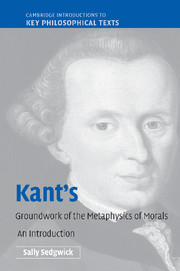Book contents
- Frontmatter
- Contents
- Preface
- List of abbreviations
- 1 Introduction
- 2 Kant's Preface
- 3 Section I: Transition from common rational to philosophic moral cognition
- 4 Section II: Transition from popular moral philosophy to metaphysics of morals
- 5 Section III: Transition from metaphysics of morals to the critique of pure practical reason
- Bibliography
- Index
5 - Section III: Transition from metaphysics of morals to the critique of pure practical reason
Published online by Cambridge University Press: 05 June 2012
- Frontmatter
- Contents
- Preface
- List of abbreviations
- 1 Introduction
- 2 Kant's Preface
- 3 Section I: Transition from common rational to philosophic moral cognition
- 4 Section II: Transition from popular moral philosophy to metaphysics of morals
- 5 Section III: Transition from metaphysics of morals to the critique of pure practical reason
- Bibliography
- Index
Summary
THE STRUCTURE AND DIFFICULTY OF SECTION III
We know from our discussion of Kant's concluding remarks in Section II that he understands the task of Section III of the Groundwork as that of proving a priori the possibility of the categorical imperative. As we have seen, he takes this task to be equivalent to that of demonstrating that morality for us is “no phantom” (445). We know, moreover, that the proof he will provide will be “synthetic” in contrast to the “analytic” demonstrations of Sections I and II.
The reader should not look for evidence of Kant's synthetic proof in the opening paragraphs of Section III, however. In these first paragraphs, Kant instead highlights key implications of the conceptual analysis he has performed in the earlier sections of the text. He tries once again to draw a clear line between the results of his discussion in the Groundwork so far and the work he has yet to complete.
The synthetic proof gets underway, finally, at (450). It is there that Kant sets out to justify our right to think of ourselves as beings possessing free will and necessarily bound to the moral law. He summarizes his argument in the section, “How is a Categorical Imperative Possible?” In the final paragraphs of Section III, he further elucidates the nature of the proof he has provided. In addition, he cautions us against making unwarranted knowledge claims about the reality of our freedom.
- Type
- Chapter
- Information
- Kant's Groundwork of the Metaphysics of MoralsAn Introduction, pp. 168 - 198Publisher: Cambridge University PressPrint publication year: 2008

